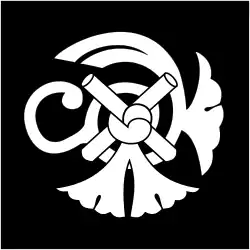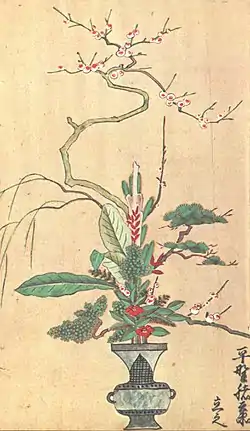立花
Japanese
Etymology 1

立花 (Tachibana): the Tachibana kamon or family crest.
| Kanji in this term | |
|---|---|
| 立 | 花 |
| たち Grade: 1 |
はな > ばな Grade: 1 |
| kun’yomi | |
Compound of 立ち (tachi, “standing”, the 連用形 (ren'yōkei, “continuative or stem form”) of verb 立つ tatsu, “to stand”) + 花 (hana, “flower”). The hana changes to bana as an instance of rendaku (連濁).
Pronunciation
- IPA(key): [ta̠t͡ɕiba̠na̠]
Usage notes
The rikka reading may be more common for the ikebana school sense.
Etymology 2

| Kanji in this term | |
|---|---|
| 立 | 花 |
| りつ > りっ Grade: 1 |
か Grade: 1 |
| on’yomi | |
/rikkwa/ → /rikka/
Possibly from Middle Chinese compound 立花 (MC liɪp̚ hˠua, “lit. stand + flower”) or 立華 (MC liɪp̚ hˠua, “lit. stand + flower”).
Alternatively, coined in Japan of Middle Chinese-derived components.
Alternative forms
- 立華
Pronunciation
Noun
Proper noun
This article is issued from Wiktionary. The text is licensed under Creative Commons - Attribution - Sharealike. Additional terms may apply for the media files.